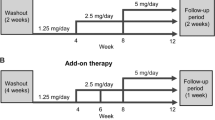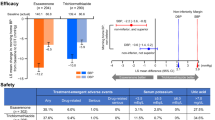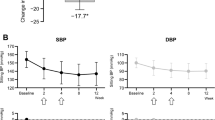Abstract
Mineralocorticoid receptor (MR) is involved in the mechanisms of blood pressure elevation, organ fibrosis, and inflammation. MR antagonists have been used in patients with hypertension, heart failure, or chronic kidney disease. Esaxerenone, a recently approved MR blocker with a nonsteroidal structure, has demonstrated a strong blood pressure-lowering effect. However, blood pressure reduction may lead to sympathetic activation through the baroreflex. The effect of esaxerenone on the sympathetic nervous system remains unclear. We investigated the effect of esaxerenone on organ damage and the sympathetic nervous system in salt-loaded stroke-prone spontaneously hypertensive rats (SHRSP), a well-established model of essential hypertension with sympathoexcitation and organ damage. Three-week administration of esaxerenone or hydralazine successfully attenuated the blood pressure elevation. Both esaxerenone and hydralazine comparably suppressed left ventricular hypertrophy and urinary albumin excretion. However, renal fibrosis and glomerular sclerosis were suppressed by esaxerenone but not hydralazine. Furthermore, plasma norepinephrine level, a parameter of systemic sympathetic activity, was significantly increased by hydralazine but not by esaxerenone. Consistent with these findings, the activity of the control centers of sympathetic nervous system, the parvocellular region of the paraventricular nucleus in the hypothalamus and the rostral ventrolateral medulla, was enhanced by hydralazine but remained unaffected by esaxerenone. These results suggest that esaxerenone effectively lowers blood pressure without inducing reflex sympathetic nervous system activation. Moreover, the organ-protective effects of esaxerenone appear to be partially independent of its blood pressure-lowering effect. In conclusion, esaxerenone demonstrates a blood pressure-lowering effect without concurrent sympathetic activation and exerts organ-protective effects in salt-loaded SHRSP.

Esaxerenone has antihypertensive and cardiorenal protective effects without reflex sympathetic activation in salt-loaded stroke-prone spontaneously hypertensive rats.
This is a preview of subscription content, access via your institution
Access options
Subscribe to this journal
Receive 12 print issues and online access
$259.00 per year
only $21.58 per issue
Buy this article
- Purchase on SpringerLink
- Instant access to full article PDF
Prices may be subject to local taxes which are calculated during checkout






Similar content being viewed by others
References
Ferreira NS, Tostes RC, Paradis P, Schiffrin EL. Aldosterone, inflammation, immune system, and hypertension. Am J Hypertens. 2021;34:15–27.
Pitt B, Zannad F, Remme WJ, Cody R, Castaigne A, Perez A, et al. The effect of spironolactone on morbidity and mortality in patients with severe heart failure. Randomized Aldactone Evaluation Study Investigators. N Engl J Med. 1999;341:709–17.
Ando K, Ohtsu H, Uchida S, Kaname S, Arakawa Y, Fujita T. Anti-albuminuric effect of the aldosterone blocker eplerenone in non-diabetic hypertensive patients with albuminuria: a double-blind, randomised, placebo-controlled trial. Lancet Diabetes Endocrinol. 2014;2:944–53.
Liu L, Xu B, Ju Y. Addition of spironolactone in patients with resistant hypertension: a meta-analysis of randomized controlled trials. Clin Exp Hypertens. 2017;39:257–63.
Zhao D, Liu H, Dong P, Zhao J. A meta-analysis of add-on use of spironolactone in patients with resistant hypertension. Int J Cardiol. 2017;233:113–7.
Arai K, Homma T, Morikawa Y, Ubukata N, Tsuruoka H, Aoki K, et al. Pharmacological profile of CS-3150, a novel, highly potent and selective non-steroidal mineralocorticoid receptor antagonist. Eur J Pharmacol. 2015;761:226–34.
Rakugi H, Ito S, Itoh H, Okuda Y, Yamakawa S. Long-term phase 3 study of esaxerenone as mono or combination therapy with other antihypertensive drugs in patients with essential hypertension. Hypertens Res. 2019;42:1932–41.
Arai K, Tsuruoka H, Homma T. CS-3150, a novel non-steroidal mineralocorticoid receptor antagonist, prevents hypertension and cardiorenal injury in Dahl salt-sensitive hypertensive rats. Eur J Pharmacol. 2015;769:266–73.
Li L, Guan Y, Kobori H, Morishita A, Kobara H, Masaki T, et al. Effects of the novel nonsteroidal mineralocorticoid receptor blocker, esaxerenone (CS-3150), on blood pressure and urinary angiotensinogen in low-renin Dahl salt-sensitive hypertensive rats. Hypertens Res. 2019;42:769–78.
Ito S, Itoh H, Rakugi H, Okuda Y, Yoshimura M, Yamakawa S. Double-blind randomized phase 3 study comparing esaxerenone (CS-3150) and eplerenone in patients with essential hypertension (ESAX-HTN Study). Hypertension. 2020;75:51–8.
Itoh H, Ito S, Rakugi H, Okuda Y, Nishioka S. Efficacy and safety of dosage-escalation of low-dosage esaxerenone added to a RAS inhibitor in hypertensive patients with type 2 diabetes and albuminuria: a single-arm, open-label study. Hypertens Res. 2019;42:1572–81.
Iwahana T, Saito Y, Okada S, Kato H, Ono R, Kobayashi Y. Safety and efficacy of esaxerenone in Japanese hypertensive patients with heart failure with reduced ejection fraction: a retrospective study. PLoS ONE. 2021;16:e0259485. https://doi.org/10.1371/journal.pone.0259485
Bhuiyan AS, Rafiq K, Kobara H, Masaki T, Nakano D, Nishiyama A. Effect of a novel nonsteroidal selective mineralocorticoid receptor antagonist, esaxerenone (CS-3150), on blood pressure and renal injury in high salt-treated type 2 diabetic mice. Hypertens Res. 2019;42:892–902.
Rahman A, Sawano T, Sen A, Hossain A, Jahan N, Kobara H, et al. Cardioprotective effects of a nonsteroidal mineralocorticoid receptor blocker, esaxerenone, in Dahl salt-sensitive hypertensive rats. Int J Mol Sci. 2021;22:2069. https://doi.org/10.3390/ijms22042069
Fu Q, Zhang R, Witkowski S, Arbab-Zadeh A, Prasad A, Okazaki K, et al. Persistent sympathetic activation during chronic antihypertensive therapy: a potential mechanism for long term morbidity? Hypertension. 2005;45:513–21.
Toal CB, Meredith PA, Elliott HL. Long-acting dihydropyridine calcium-channel blockers and sympathetic nervous system activity in hypertension: a literature review comparing amlodipine and nifedipine GITS. Blood Press. 2012;21:3–10.
Dietz R, Schömig A, Rascher W, Strasser R, Kübler W. Enhanced sympathetic activity caused by salt loading in spontaneously hypertensive rats. Clin Sci. 1980;59:171s–3s.
Dietz R, Schömig A, Rascher W, Strasser R, Lüth JB, Ganten U, et al. Contribution of the sympathetic nervous system to the hypertensive effect of a high sodium diet in stroke-prone spontaneously hypertensive rats. Hypertension. 1982;4:773–81.
Zhang W, Liu AJ, Yi-Ming W, Liu JG, Shen FM, Su DF. Pressor and non-pressor effects of sodium loading on stroke in stroke-prone spontaneously hypertensive rats. Clin Exp Pharmacol Physiol. 2008;35:83–8.
Honda N, Hirooka Y, Ito K, Matsukawa R, Shinohara K, Kishi T, et al. Moxonidine-induced central sympathoinhibition improves prognosis in rats with hypertensive heart failure. J Hypertens. 2013;31:2300–8.
Raij L, Azar S, Keane W. Mesangial immune injury, hypertension, and progressive glomerular damage in Dahl rats. Kidney Int. 1984;26:137–43.
Dampney RAL. Central neural control of the cardiovascular system: current perspectives. Adv Physiol Educ. 2016;40:283–96.
Ayuzawa N, Fujita T. The mineralocorticoid receptor in salt-sensitive hypertension and renal injury. J Am Soc Nephrol. 2021;32:279–89.
Brown NJ. Contribution of aldosterone to cardiovascular and renal inflammation and fibrosis. Nat Rev Nephrol. 2013;9:459–69.
Shibata S, Nagase M, Yoshida S, Kawarazaki W, Kurihara H, Tanaka H, et al. Modification of mineralocorticoid receptor function by Rac1 GTPase: implication in proteinuric kidney disease. Nat Med. 2008;14:1370–6.
Takeda Y, Yoneda T, Demura M, Furukawa K, Miyamori I, Mabuchi H. Effects of high sodium intake on cardiovascular aldosterone synthesis in stroke-prone spontaneously hypertensive rats. J Hypertens. 2001;19:635–9.
Arai K, Morikawa Y, Ubukata N, Tsuruoka H, Homma T. CS-3150, a Novel nonsteroidal mineralocorticoid receptor antagonist, shows preventive and therapeutic effects on renal injury in deoxycorticosterone acetate/salt-induced hypertensive rats. J Pharmacol Exp Ther. 2016;358:548–57.
Kai H, Kuwahara F, Tokuda K, Imaizumi T. Diastolic dysfunction in hypertensive hearts: roles of perivascular inflammation and reactive myocardial fibrosis. Hypertens Res. 2005;28:483–90.
Fujiwara T, Yuasa H, Ogiku N, Kawai Y. Histopathological investigation on salt-loaded stroke-prone spontaneously hypertensive rats, whose biochemical parameters of renal dysfunction were ameliorated by administration of imidapril. Jpn J Pharmacol. 1994;66:231–40.
Bauersachs J, Jaisser F, Toto R. Mineralocorticoid receptor activation and mineralocorticoid receptor antagonist treatment in cardiac and renal diseases. Hypertension. 2015;65:257–63.
Benarroch EE. Paraventricular nucleus, stress response, and cardiovascular disease. Clin Auton Res. 2005;15:254–63.
Guyenet PG. The sympathetic control of blood pressure. Nat Rev Neurosci. 2006;7:335–46.
Kim J, Padanilam BJ. Renal nerves drive interstitial fibrogenesis in obstructive nephropathy. J Am Soc Nephrol. 2013;24:229–42.
Kim J, Padanilam BJ. Renal denervation prevents long-term sequelae of ischemic renal injury. Kidney Int. 2015;87:350–8.
Osborn JW, Tyshynsky R, Vulchanova L. Function of renal nerves in kidney physiology and pathophysiology. Annu Rev Physiol. 2021;83:429–50.
Ito K, Hirooka Y, Sunagawa K. Blockade of mineralocorticoid receptors improves salt-induced left-ventricular systolic dysfunction through attenuation of enhanced sympathetic drive in mice with pressure overload. J Hypertens. 2010;28:1449–58.
Nakagaki T, Hirooka Y, Matsukawa R, Nishihara M, Nakano M, Ito K, et al. Activation of mineralocorticoid receptors in the rostral ventrolateral medulla is involved in hypertensive mechanisms in stroke-prone spontaneously hypertensive rats. Hypertens Res. 2012;35:470–6.
Nakano M, Hirooka Y, Matsukawa R, Ito K, Sunagawa K. Mineralocorticoid receptors/epithelial Na(+) channels in the choroid plexus are involved in hypertensive mechanisms in stroke-prone spontaneously hypertensive rats. Hypertens Res. 2013;36:277–84.
Iyonaga T, Shinohara K, Mastuura T, Hirooka Y, Tsutsui H. Brain perivascular macrophages contribute to the development of hypertension in stroke-prone spontaneously hypertensive rats via sympathetic activation. Hypertens Res. 2020;43:99–110.
xMaemura S, Niwa M, Ozaki M. Characteristic alterations in adrenal catecholamine contents in SHR, SHRSP, and WKY during development of hypertension and stroke. Jpn Heart J. 1982;23:593–602.
Katsurada K, Kario K. Sympathetic modulation by antihypertensive drugs. J Clin Hypertens. 2021;23:1715–7.
Hirooka Y. Sympathetic activation in hypertension: importance of the central nervous system. Am J Hypertens. 2020;33:914–26.
Malpas SC. Sympathetic nervous system overactivity and its role in the development of cardiovascular disease. Physiol Rev. 2010;90:513–57.
Mancia G, Grassi G. The autonomic nervous system and hypertension. Circ Res. 2014;114:1804–14.
Arai K, Morikawa Y, Ubukata N, Sugimoto K. Synergistic reduction in albuminuria in type 2 diabetic mice by esaxerenone (CS-3150), a novel nonsteroidal selective mineralocorticoid receptor blocker, combined with an angiotensin II receptor blocker. Hypertens Res. 2020;43:1204–13.
Kario K, Nishizawa M, Kato M, Ishii H, Uchiyama K, Nagai M, et al. Nighttime home blood pressure lowering effect of esaxerenone in patients with uncontrolled nocturnal hypertension: the EARLY-NH study. Hypertens Res. 2023;46:1782–94.
Katsuya T, Inobe Y, Uchiyama K, Nishikawa T, Hirano K, Kato M, et al. Exploratory study on the relationship between urinary sodium/potassium ratio, salt intake, and the antihypertensive effect of esaxerenone: the ENaK Study. Hypertens Res. 2024. https://doi.org/10.1038/s41440-023-01519-0
Mogi M. Aldosterone breakthrough from a pharmacological perspective. Hypertens Res. 2022;45:967–75.
Kishi T, Hirooka Y, Sunagawa K. Telmisartan reduces mortality and left ventricular hypertrophy with sympathoinhibition in rats with hypertension and heart failure. Am J Hypertens. 2014;27:260–7.
Siegel AK, Kossmehl P, Planert M, Schulz A, Wehland M, Stoll M, et al. Genetic linkage of albuminuria and renal injury in Dahl salt-sensitive rats on a high-salt diet: comparison with spontaneously hypertensive rats. Physiol Genomics. 2004;18:218–25.
Acknowledgements
This work was supported by grants from Daiichi Sankyo Co., Ltd. and, in part, JSPS (KAKENHI Grant Number JP21K08032) to KS.
Author information
Authors and Affiliations
Corresponding author
Ethics declarations
Conflict of interest
KS reports grants from Daiichi Sankyo, Nippon Boehringer Ingelheim, and Otsuka Medical Devices. HT reports grants and/or personal fees from Daiichi Sankyo, Novartis Pharma, Otsuka Pharmaceutical, Pfizer Japan, Mitsubishi Tanabe Pharma, Teijin Pharma, Nippon Boehringer Ingelheim, AstraZeneca, Ono Pharmaceutical, Kowa, IQVIA Service Japan, MEDINET, Medical Innovation Kyushu, Bayer Yakuhin, Johnson & Johnson, NEC, Nippon Rinsho and Japanese Heart Failure Society. The other authors report no conflicts of interest.
Additional information
Publisher’s note Springer Nature remains neutral with regard to jurisdictional claims in published maps and institutional affiliations.
Rights and permissions
Springer Nature or its licensor (e.g. a society or other partner) holds exclusive rights to this article under a publishing agreement with the author(s) or other rightsholder(s); author self-archiving of the accepted manuscript version of this article is solely governed by the terms of such publishing agreement and applicable law.
About this article
Cite this article
Ikeda, S., Shinohara, K., Kashihara, S. et al. Esaxerenone: blood pressure reduction and cardiorenal protection without reflex sympathetic activation in salt-loaded stroke-prone spontaneously hypertensive rats. Hypertens Res 47, 2133–2143 (2024). https://doi.org/10.1038/s41440-024-01733-4
Received:
Revised:
Accepted:
Published:
Issue date:
DOI: https://doi.org/10.1038/s41440-024-01733-4
Keywords
This article is cited by
-
Esaxerenone, organ protection without sympathetic activation
Hypertension Research (2024)



